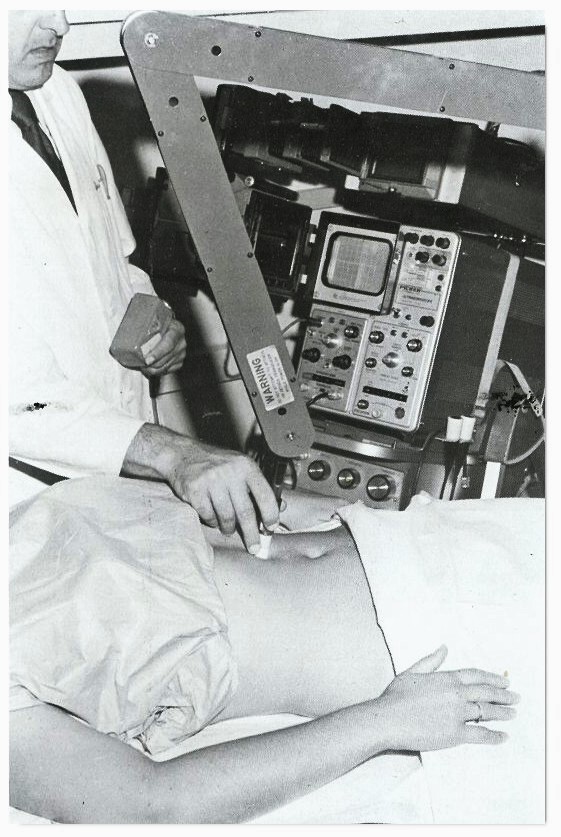Dr. Barry B. Goldberg, M.D. graduated B.A. in Chemistry and obtained his M.D. degrees from the University of Pennsylvania. He completed his internship and radiology residency at the Albert Einstein Medical Center in Philadelphia.
Dr Golberg started his radiology residency in 1964, during which time he worked with J Gershon-Cohen, a pioneer in x-ray mammography. Always interested in new imaging modalities, Dr. Gershon-Cohen acquired one of the first SmithKline A-mode and M-mode ultrasound machines. He in turn encouraged Dr. Goldberg to investigate the usefulness of ultrasound during his residency. Completing his residency, Dr. Goldberg worked for a year with J. Stauffer Lehman on one of the first B-scanners at the Hahnemann Medical College and Hospital, Philadelphia.
He became involved in testing some of the earliest applications of A-mode scanning in determining the differential characteristics of solid, cystic and complex masses. His early work included studies in echoencephalography, fetal cephalometry and cardiovascular imaging.
Dr. Goldberg was on record the first to describe fetal cephalometry in 1965 outside of Britain and Europe. His research efforts resulted in establishing normal measurements for the abdominal aorta and developing a suprasternal approach to obtaining measurements of the aortic arch, right pulmonary artery, left atrium and innominate vein. In addition, he developed techniques, using special transducers containing a central lumen, for the aspiration and biopsy of masses and collections.
Dr. Goldberg is currently director of the Division of Ultrasound and Radiologic Imaging, and Professor of Radiology at Thomas Jefferson University Medical School and Hospital, a post which he had held for more than 20 years. He is also founder and director of the Jefferson Ultrasound Research and Education Institute (JUREI), the largest center for ultrasound education. The Institute in 2000 offers 50 courses dealing with different aspects of ultrasound imaging annually. More than 1,200 doctors and sonographers from more than 40 countries come yearly to take those courses. Dr. Goldberg has continued work begun in the 1960s in developing ultrasound education programs for physicians and technologists at the Thomas Jefferson University Medical School and indeed throughout the world.
Dr. Goldberg has also served as an editorial consultant or reviewer for approximately two-dozen publications dealing with healthcare and sonography. He has edited more than 20 books, written or co-written approximately 100 book chapters, and is listed as an author or co-author of nearly 200 journal articles dating from 1965.
Dr. Goldberg with one of the earliest articulated-arm scanner.
Dr. Goldberg had served as president of the American Institute of Ultrasound in Medicine (AIUM) from 1980-82. He has also served the AIUM as Chairman of the Education Committee and member of the Committee on Clinical Certification and Accreditation. He has also been the Chairman of the Archives Committees of the AIUM and World Federation of Ultrasound in Medicine and Biology (WFUMB). He is co-author of the important AIUM historical monograph: "Medical Diagnostic Ultrasound: A Retrospective on its 40th Anniversary". His current interests are in doppler ultrasound, contrast enhancements, neuro- and endoluminal sonography, ultrasound training and education, and historical aspects of the development of ultrasound in medicine.
Dr. Goldberg has also been the treasurer and President (1994 - 97) of the World Federation of Ultrasound in Medicine and Biology. During his tenure, he was the Chairman of the WHO Scientific Study Group on Training in Diagnostic Ultrasonography. The Group produced in 1996 a detailed document outlining the needs and essentials for ultrasound training throughout the world.At the 1998 RSNA scientific assembly, Dr. Goldberg received the Outstanding Researcher Award from the Society. RSNA's President David B. Fraser called Dr Goldberg ">B>the embodiment of the physician-scientist who not only has done key innovative work in his field, but has provided leadership and training to generations of ultrasound specialists worldwide."
Read here of Dr. Goldberg's own story of his start in ultrasound and the a history of ultrasound development in the United States in the last 40 years and also here.
Back to History of Ultrasound in Obstetrics and Gynecology.
